There was a time when playing games meant you had to use Microsoft Windows. But things have changed. Linux (a free, open-source operating system) is now more popular than ever.
It’s true that Linux still isn’t as widely used as Windows or macOS. But more and more people are starting to see how powerful and useful Linux can be, even for gaming.
There are thousands of games you can play on Linux. When you include classic game emulators, Windows games that work on Linux, and everything available on the Steam Store, Linux might actually have more games than any other platform.
Of course, to run the games, you will need the right Linux distribution to do it. While you can transform any Linux distribution into a Linux gaming machine, there are several Linux distros out there that are designed specifically for gaming.
These distributions come with everything you need for gaming, so you don’t have to spend hours setting up your system just to play your favorite game. Let’s look at the eight best Linux distributions for gaming and decide which one will be right for you and your gaming needs.
Table of Contents
1. Steam OS
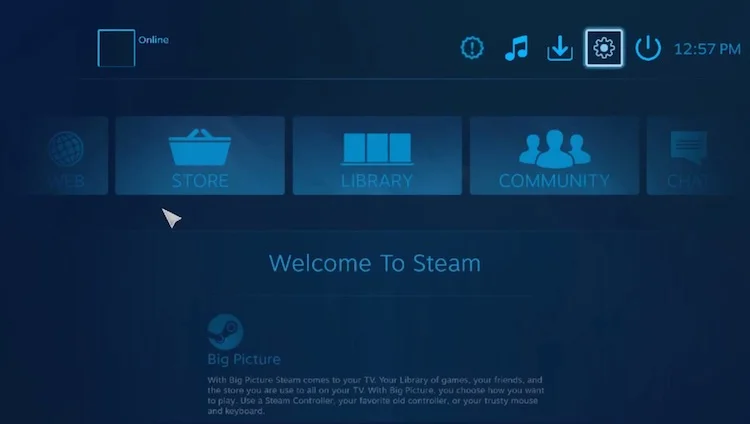
Base: Debian
Desktop Environment: Gnome
Package Format: DEB
Originally designed for the Steam Machine, Valve has also made the Linux-based operating system available for download, but with limited support. Out of the box, you will find drivers ready to go to support a huge variety of video cards and controllers/joysticks.
Combine that with its smooth integration with the Steam Store and Steam games built for Linux, and you have a Linux operating system that is perfect for gaming. However, the setup can be difficult for anyone who has never used Linux before, and the hardware requirements are somewhat higher compared to other Linux distributions.
It also uses many different proprietary drivers, which may annoy some open-source purists. But if you can get through the initial setup process, you will be hard-pressed to find a better Linux distribution designed for gaming.
Pros
- Smooth user interface
- Supports many different graphics cards
- Huge controller/joystick support
- Out-of-the-box compatibility with the Steam Store
Cons
- High-end hardware requirements
- Only works with Steam games out of the box
- Manual setup may be difficult for non-technical users
Hardware Requirements
- Intel or AMD 64-bit processor
- 4GB RAM or more
- 250GB or larger hard drive
- USB port or DVD drive for installation
Bottom Line
If you are a fan of Steam and want to play your favorite games, this is by far the best option. Just make sure your machine meets the admittedly high system requirements.
2. Sparky Linux Gameover Edition
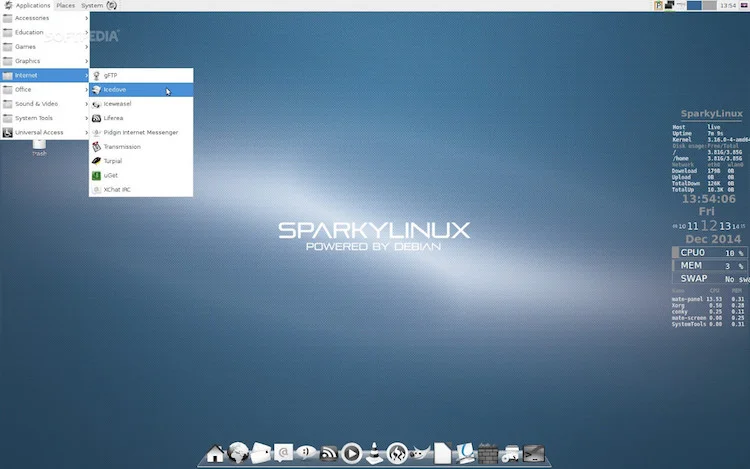
Base: Debian
Desktop Environment: Openbox
Package Format: DEB
Sparky Linux Gameover Edition may not be as well-known as some distros of Linux, but in terms of gaming features, it’s hard to beat. This Linux distribution comes with tools that support multiple types of emulation so you can play all sorts of games right after you complete your install.
If you are a Steam user, you will quickly find easy support for your favorite Steam games, much like Steam OS. It even includes Wine and PlayOnLinux, so you can install and run your favorite Windows games. It even provides a utility to help you find the best drivers for your hardware, so you get the best performance out of your Linux gaming machine.
But, Sparky Linux isn’t for everyone. It uses the OpenBox graphical interface, which, while powerful, isn’t quite as polished and pretty as some of the other graphical interfaces out there. Of course, you can choose to use something different, but that will require a little Linux know-how to get it done.
Support is also somewhat limited. Yes, you can find help on their official forums, and the developers are pretty responsive, but because this distro isn’t as popular, the community of support is simply smaller. That means you could be left to figure things out for yourself.
Pros
- Support for Steam Games
- Wine and PlayOnLinux for Windows games
- Multiple emulation support
Cons
- Interface is not as pretty
- Limited online support
Hardware Requirements
- Intel or AMD 64-bit processor
- 256MB or more RAM
- 20GB or larger hard drive
- USB port or DVD drive for installation
Bottom Line
If you want a system that supports a wide assortment of Linux games right out of the box and don’t mind that the interface isn’t quite as pretty as other options, then this is the best distribution for you.
3. Ubuntu GamePack
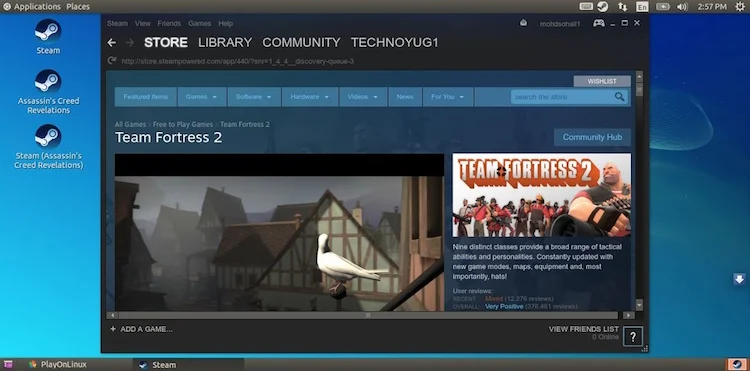
Base: Ubuntu
Desktop Environment: Unity/Gnome
Package Format: DEB
While Ubuntu may not be the king of Linux distributions today, I believe it’s hard to argue that it’s not the most recognized distro in the world. Ubuntu GamePack is not Ubuntu, but an independent distribution that is based on Ubuntu. As such, if you have ever used Ubuntu, and if you’ve ever tried Linux, I bet you have, Ubuntu GamePack will feel very familiar.
It comes with Steam, Lutris, Wine, and PlayOnLinux installed from the get-go, so it will support thousands of games across a multitude of platforms. Add to that the great hardware support for video cards, controllers, and more, and you have a Linux distro that is perfect for any gamer out there.
Of course, it’s not perfect. Because it’s based on Ubuntu, you will have many of the same annoyances, such as ads for services and Amazon integration built-in, that caused many to flee from the distribution in the first place.
Ubuntu is also known for being a little more resource-heavy compared to other distributions. While Ubuntu GamePack has optimized it to be more efficient, it’s a safe bet that it will still take a little more power for this distro to perform at its very best.
Pros
- Familiar and advanced interface
- Support for Steam, Lutris, Wine, and PlayOnLinux out of the box
- Huge support for a variety of hardware
- Amazing support from a large community
Cons
- System requirements are on the high side
- Ads on the desktop are much like vanilla Ubuntu
Hardware Requirements
- 2 GHz or more processor (64-bit recommended)
- 1GB RAM or more
- 9GB disk (the more, the better)
- VGA capable of 1024×768 screen resolution. Intel HD Graphics/AMD Radeon 8500 for Steam games and any other GPU for other games.
Bottom Line
Ubuntu is one of the most popular distributions out there and is one of the easiest to use, making the GamePack version perfect for anyone new to Linux. But the Unity interface and the sheer number of features make this one much more resource-heavy compared to other entries on this list.
4. Fedora Games Spin

Base: Fedora
Desktop Environment: Xfce
Package Format: RPM
Fedora is another popular distribution and one of the longest-lasting, as one of the testbeds for the commercial Linux Distribution, Red Hat Linux. Fedora has a history of being bleeding edge when it comes to its technology, and as such, sometimes you may run into bugs that you won’t see on other distributions.
For its Games Spin edition, Fedora has chosen to use the Xfce desktop, which is much lighter weight compared to Gnome 3. However, the underlying technology is still Fedora, making it one of the most powerful and advanced operating systems on this list.
One of the nicest features of this distribution is the sheer number of games it comes with by default. There are thousands of games available to you, and while it still only scratches the surface of what’s out there for Linux, you will have more than enough to get you started.
Unfortunately, it doesn’t come with drivers for the latest hardware or support for Steam, Wine, and PlayOnLinux out of the box, so you will have to add this software after the installation.
Pros
- Powerful and advanced technology
- Includes a lot of games to get you started
- Great support from the community
Cons
- No third-party drivers are included for the latest hardware
- Wine, Steam, and PlayOnLinux aren’t installed by default
Hardware Requirements
- 2 GHz or more processor (64-bit recommended)
- 1GB RAM or more
- 10GB disk (the more, the better)
- Intel HD Graphics/AMD Radeon 8500 for Steam games and any other GPU for other games.
Bottom Line
Fedora Games Spin is a rock-solid operating system built on tried and true technology and includes a graphical interface that is lighter and faster than the default GUI included in most versions of Fedora. But if you are looking for Steam games or Windows games, it will require a little more work to get it ready.
5. Game Drift Linux
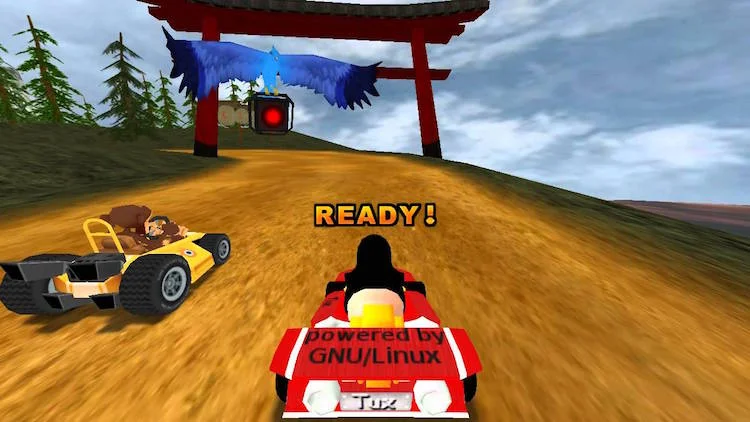
Base: Ubuntu
Desktop Environment: Mate
Package Format: DEB
Game Drift Linux is one of the most comprehensive Linux distributions for gaming that I have seen. It comes with everything you need to start gaming. It even includes its very own Games Store featuring only high-quality games that can all be installed with just one click.
The distribution is based on Ubuntu, so community support is very high, and the operating system itself is very stable. It also includes support for over 1,200 Windows games with CrossOver technology, but this software must be purchased in order to use it after you have completed the installation of the distribution.
While this distribution has been optimized for gamers, and everything just works, it is based on Ubuntu, so the hardware requirements are higher than some distributions. But it does run Mate as it’s a graphical interface, so it will be more efficient compared to Unity or Gnome 3.
Game Drift Linux is one of the most complete and feature-rich distributions out there and can provide you with an easy-to-use, complete user experience with its one-click installations and huge support for Windows games.
Pros
- Built-in games store with easy installation
- Support for many Windows games
- 4 GB hard disk drive for Game Drift Linux (excluding games)
- ATI, NVidia, or Intel graphics adapter suitable for games
Cons
- CrossOver must be purchased after installation
- Not as lightweight as other Linux distributions
Hardware Requirements
- 1-2 GHz processor (32 or 64 bit)
- 1-2 GB RAM
- 4 GB hard disk drive for Game Drift Linux (excluding games)
- ATI, NVidia, or Intel graphics adapter suitable for games
Bottom Line
Game Drift Linux is built upon the ever-stable Ubuntu and includes all the software and technology you need for a complete gaming experience, but for the best experience, you will have to spend a little money for CrossOver, which often goes against everything Linux represents.
6. Lakka
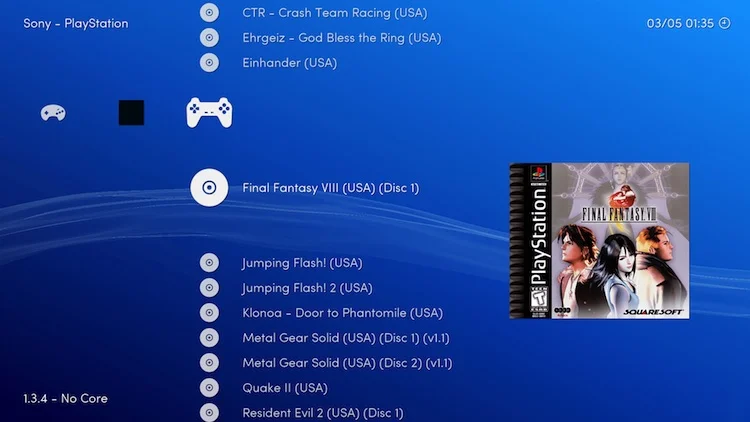
Base: OpenELEC
Desktop Environment: Custom Environment
Package Format: Not Applicable
Next on our list comes the definitive Linux distribution for retro gamers. If you love playing classic games on older platforms such as Atari, NES, Sega Genesis, and more, and you have an extra machine sitting around collecting dust, then Lakka is perfect for you.
With a wide range of emulators built into the system and the ability to install on a variety of hardware, including x86 PCs, the Raspberry Pi, and more, Lakka is a highly flexible distribution designed for classic gaming at its best. The UI is clean and clear, and the underlying systems are actually based on Kodi, formerly known as XBMC, so the interface is polished and runs perfectly for any gamer who loves playing the classics.
Pros
- Support for a wide variety of hardware
- Emulators come pre-installed
- Beautiful UI
- Out-of-the-box compatibility with the Steam Store
Cons
- Not a full version of Linux
- Limited support for modern games
- Manual setup may be difficult for non-technical users
Hardware Requirements
- Varies based on devices and what you want to run
Bottom Line
If you are a retro gamer and want to create a console-like experience while having all your emulators and games in one place, then Lakka is the distro for you. If you need your machine to double as a full computer or you want to run more modern games as well, you should look elsewhere.
7. Solus
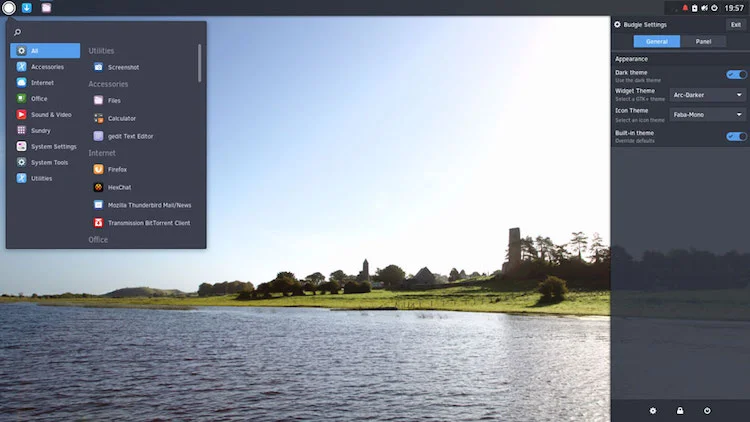
Base: None
Desktop Environment: Budgie
Package Format: eopkg Package Manager
Solus may not be as well-known as some of the others on this list, but don’t discount it. Built from the ground up, Solus doesn’t rely on any other distribution for package management or updates. It’s completely independent of all the big players. While not as lightweight as some of the others on this list, it’s by no means the beefiest, either.
Solus comes with the Budgie desktop, which is a relatively new and unique desktop environment on Linux. Its look is amazing, and it comes with many modern operating system features such as a notification center that many of us have come to expect from an operating system in 2018.
Pros
- Built as a unique Linux distribution not dependent on others
- Modern OS features are included, such as notifications
- Beautiful UI
- Gaming functionality is built in without additional software installation
Cons
- A little resource-heavy
- Relatively unknown compared to big Linux players
Hardware Requirements
- Intel/AMD CPU (64-bit recommended)
- 2GB RAM Minimum, 4 GB+ recommended
- 10GB+ storage
- ATI, NVidia, or Intel GPU suitable for games
Bottom Line
Solus is the perfect Linux distribution for anyone who is tired of the big players in the Linux world and wants to try an operating system that is feature-rich and fully functional for both gaming and regular usage.
8. Manjaro Gaming Edition (mGAMe)
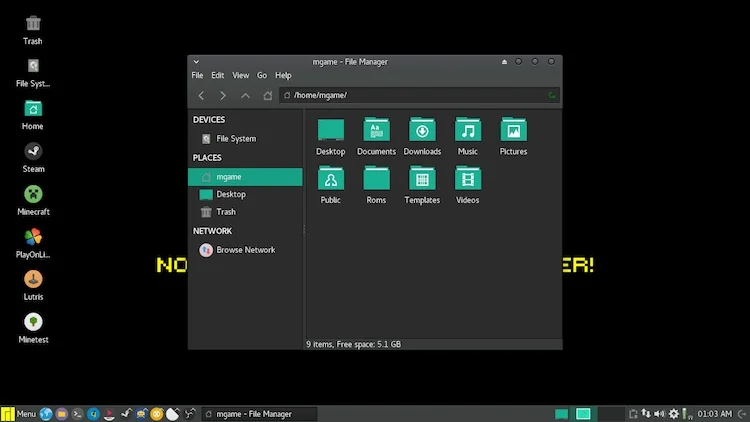
Base: Arch Linux
Desktop Environment: Xfce
Package Format: Pacman
Another great Linux distribution for retro gamers, Manjaro Gaming Edition, gives users a lot more than Lakka. Featuring a full desktop powered by the lightweight yet feature-rich Xfce desktop, users will be able to use this retro powerhouse as a full desktop, and all the software you will need for daily computing are readily available.
But there is more to Manjaro than just retro gaming. It includes support for Steam, though it isn’t installed out of the box. However, pretty much everything else you will need is there. This includes software features such as PlayOnLinux, Wine, and much more.
Pros
- Pre-installed emulators and gaming software
- Xfce is lightweight yet modern in design
- Steam easily installed
- Rolling release of updates so you are always up to date
Cons
- Steam must be installed manually
- Some software may require manual installation because of repository support
Hardware Requirements
- At least 1GHz processor
- At least 1GB RAM
- At Least 30GB storage
- ATI, NVidia, or Intel GPU suitable for games and HD
Bottom Line
If you want an OS that does things a little differently but comes with everything you need for both work and play, Manjaro Gaming Edition is tough to beat.
9. Pop!_OS
Base: Ubuntu LTS (Long-Term Support)
Desktop Environment: COSMIC
Package Format: DEB and Flatpak support
Pop!_OS is a modern and user-friendly Linux distribution developed by System76. It is designed to deliver a clean, polished experience that caters to casual and power users, including gamers, developers, and engineers.
One of the standout features of Pop!_OS is its seamless hardware compatibility, especially for systems equipped with NVIDIA or AMD GPUs. The OS emphasizes performance and resource management. It includes system optimizations and support for performance tuning via tools like GameMode, which ensures games run at optimal performance levels by allocating system resources more efficiently.
For gamers, Pop!_OS makes things easier by supporting Steam, Lutris, and GameHub. It also works well with Proton and Wine, so you can run Windows games without any trouble.
Pros
- Excellent GPU support
- Strong community and System76 backing
- Out-of-the-box gaming compatibility
Cons
- No 32-bit version
- Not the lightest distro for extremely low-spec hardware
Hardware Requirements
- Dual-core 64-bit processor
- 4 GB and 20 GB of storage
- 64-bit only
Bottom Line
Whether you’re playing AAA titles on Steam or running indie games from itch.io, Pop!_OS provides the compatibility, performance, and simplicity needed to make gaming on Linux a serious alternative to Windows.
10. Garuda Linux
Base: Arch Linux
Desktop Environment: KDE Plasma, GNOME, XFCE, and LXQt
Package Format: Pacman + AUR (Arch User Repository)
Garuda Linux is a visually striking and performance-optimized Linux distribution that places a heavy emphasis on gaming. It is integrated with a Linux Zen Kernel, a performance-tuned kernel that offers better responsiveness and lower latency than the standard kernel.
It comes with pre-installed gaming tools and compatibility layers such as Steam, Lutris, Wine, and Proton GE, allowing users to launch and play both native and Windows-based games with minimal setup. It also includes Garuda Gamer, a one-stop GUI tool that allows users to install a wide range of gaming software and emulators with a few clicks.
Plus, Garuda is one of the few Linux distros that comes with “btrfs” as the default file system. Paired with automated snapshots via Timeshift, it ensures data safety and easy rollback, which is great for gamers who frequently update drivers or tweak system settings.
Pros
- Pre-installed gaming tools
- Garuda Gamer GUI tool
- Btrfs with automatic snapshots
Cons
- System resource-heavy
- Requires regular updates
Hardware Requirements
- Quad-core or higher
- 8 GB and 30 GB of storage
- Dedicated GPU with Vulkan support
Bottom Line
While it may not be the best fit for older hardware or users who prefer stability over freshness, Garuda offers a top-tier experience for modern gaming rigs. With Zen Kernel optimization and automatic rollback capabilities, Garuda Linux makes Linux gaming powerful, fast, and visually stunning.
11. Nobara Project
Base: Fedora
Desktop Environment: GNOME, KDE Plasma
Package Format: RPM + Flatpak support
Nobara is developed to remove the barriers typically associated with Fedora’s stricter open-source stance, making the system ready for gaming, streaming, and content creation right out of the box.
While Fedora leans heavily on free/libre software ideals and often excludes proprietary media codecs and drivers, Nobara fills that gap by bundling in essential third-party tools, proprietary GPU drivers (like NVIDIA), multimedia codecs, and game launchers such as Steam, Lutris, Wine, and OBS Studio.
Unlike Arch-based distros that rely on bleeding-edge updates and DIY configuration, Nobara offers a curated, plug-and-play experience that’s beginner-friendly but powerful enough for advanced use.
Pros
- Includes proprietary GPU drivers and codecs
- Fedora-based stability
- Proton GE integration for running various Windows games
Cons
- Slightly larger ISO size and heavier installation footprint
- Not officially backed by Fedora or Red Hat
Hardware Requirements
- Quad-core or better
- 8 GB and 30 GB of storage
- 64-bit architecture
Bottom Line
With practical enhancements like the latest Proton GE builds, Feral’s GameMode, custom OBS patches, and game controller fixes, Nobara has carved out a unique niche in the Linux gaming ecosystem. It is ideal for users who want Fedora’s stability with none of its open-source limitations,
Parting Thoughts
There’s never been a better time to game on Linux. These Linux distributions are some of the best options for gaming. They come with everything you need to start playing and include the tools and features that let you enjoy games from nearly any platform.
Whether you’re gaming on a laptop or desktop, one of these Linux distributions will be a great fit. They let you play almost any type of game on a free, open-source system that’s reliable and stable.
Read More



the most widely known OS based on the Linux kernel is Google’s AndroidOS, although it is used only on smartphones and tablets, not on PCs. On PCs, the most popular are the likes of Ubuntu, CentOS, Debian, openSUSE, Arch Linux, Fedora, Valve’s SteamOS, and many more, all of which are entirely free and built upon by various developers.
Ultimately, however, Linux is aimed more towards professional users and enthusiasts due to its powerful features, flexibility, and lower hardware requirements as compared to Windows. That said, the interface could seldom be called “user-friendly” and Linux-compatible software is not exactly in high supply.
How did you not cover “Pop!_OS”?
SteamOS is an Arch Linux based Linux distribution.